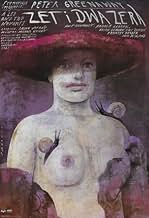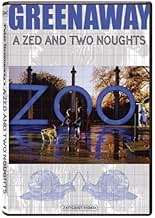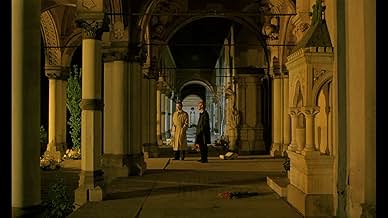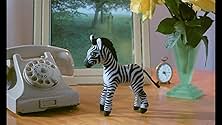PUNTUACIÓN EN IMDb
7,2/10
8 mil
TU PUNTUACIÓN
Añade un argumento en tu idiomaTwin zoologists lose their wives in a car accident and become obsessed with decomposing animals.Twin zoologists lose their wives in a car accident and become obsessed with decomposing animals.Twin zoologists lose their wives in a car accident and become obsessed with decomposing animals.
- Dirección
- Guión
- Reparto principal
Reseñas destacadas
All you need to make cinema is a point of view (and of course the view to which it points). Or a frame of reference and the reference which it frames. In Greenaway all these exist together, knowingly, as forms within forms.
A story of twins looking to overcome grief by studying the decay of death is the reference here. Zebras, lizards, swans, we see the empty shells of body decay before the camera. Kept under the scrutiny of our gaze in life, inside cages, they remain under it once dead. At what point do all these symmetries which conjoined together make up the miracle of life stop being the sum of their parts, and by which process; how much of these parts that we understand as the self can be taken out before the self is no longer recognized; and the symmetry once broken, what mystery renews it.
These obscure ruminations are framed against the question of existence, which implies god and pattern. How come that something so systemised, so perfectly designed and evolved from nothing, from amoeba and algea, can come to pass by the whim of chance? Having taken millions of years for creation to unravel its complexity, why does it take a second to destroy it? Which is to ask, at what point does the system, which in hindsight appears ordained and patterned, become random and meaningless.
Various eccentricities are enacted in this process, all pointing to some kind of symbolic nakedness.
When the legless woman gives birth to new life, twins again, the old twins, the blueprint for them, must step aside. The film ends with an poignant thought. Having carefully staged their own death so that the decay that follows may be captured on film, we see how nature intrudes upon this scene and foils the effort.
An atheist himself, Greenaway here gives us a pessimism that cuts deep; no consciousness survives this.
A story of twins looking to overcome grief by studying the decay of death is the reference here. Zebras, lizards, swans, we see the empty shells of body decay before the camera. Kept under the scrutiny of our gaze in life, inside cages, they remain under it once dead. At what point do all these symmetries which conjoined together make up the miracle of life stop being the sum of their parts, and by which process; how much of these parts that we understand as the self can be taken out before the self is no longer recognized; and the symmetry once broken, what mystery renews it.
These obscure ruminations are framed against the question of existence, which implies god and pattern. How come that something so systemised, so perfectly designed and evolved from nothing, from amoeba and algea, can come to pass by the whim of chance? Having taken millions of years for creation to unravel its complexity, why does it take a second to destroy it? Which is to ask, at what point does the system, which in hindsight appears ordained and patterned, become random and meaningless.
Various eccentricities are enacted in this process, all pointing to some kind of symbolic nakedness.
When the legless woman gives birth to new life, twins again, the old twins, the blueprint for them, must step aside. The film ends with an poignant thought. Having carefully staged their own death so that the decay that follows may be captured on film, we see how nature intrudes upon this scene and foils the effort.
An atheist himself, Greenaway here gives us a pessimism that cuts deep; no consciousness survives this.
This fine film is written in an intelligent, multilayered way of such a degree and quality as I have only seen in top-notch theatre. Greenaway delivers a dark but intoxicating tale of decay, evolution and the crucial importance of symmetry.
The themes of this film emerge not only through Greenaway's script, but also through the images produced by his tight, clear directing. The choice of images and ability to linger on single shots suggests a creative mind as focused and obsessed as the characters he portrays.
As with many of Greenaway's works, this certainly isn't a film for anyone wanting a cheap thrill and easy satisfaction. Its particularly dark humour and images of accelerated decay and death are more likely to please those who prefer to view film as a medium of art than those seeking mere entertainment.
It is a very long time since a film has impressed me quite as much as this.
The themes of this film emerge not only through Greenaway's script, but also through the images produced by his tight, clear directing. The choice of images and ability to linger on single shots suggests a creative mind as focused and obsessed as the characters he portrays.
As with many of Greenaway's works, this certainly isn't a film for anyone wanting a cheap thrill and easy satisfaction. Its particularly dark humour and images of accelerated decay and death are more likely to please those who prefer to view film as a medium of art than those seeking mere entertainment.
It is a very long time since a film has impressed me quite as much as this.
For better or for worse, A Zed & Two Noughts is a very unusual film. This is hardly surprising given that it was directed by the avant-gardist director Peter Greenaway. It begins with a car accident at a zoo, where two women are killed when their vehicle collides with a pregnant swan. These women are twins who were in turn married to a couple of twin zoologists, Oliver and Oswald Deuce. Shortly afterwards these men start simultaneous affairs with the survivor of the accident, the driver Alba Bewick who lost a leg as a result of the crash. She later has the other one removed surgically for symmetrical reasons and falls pregnant to the twins.
This strange film features both the good and the bad typical of Greenaway. The good is the visual presentation and distinctive bizarre qualities, the bad is more or less any time someone opens their mouths, which unfortunately is quite often. Greenaway is really terrible at writing dialogue. His script constantly tries to be clever, which is not the same thing as actually being clever. Needless to say, the dialogue is painful to listen to and ultimately makes the film hard work and not in a good way. But setting this aside, amongst other things, it's an intriguing concoction about symmetry, birth and decay. Of the latter are several time-lapse films showing a variety of animals and organic matter decaying - films which were fascinating and repulsive in equal measure. We also have excellent cinematography from Greenaway's common collaborator Sacha Vierney, with many shots being a joy to behold. The other significant cog in the wheel is the typically persistent minimalist score from Michael Nyman, which is sometimes brilliant even if it does border on irritating at others. We also have the most unexpected collaborator in any Greenaway film - none other than Jim 'Nick Nick' Davidson, the politically incorrect stand-up comedian who appears as a zoo-keeper.
In summary, A Zed & Two Noughts was an interesting film spoiled by Greenaway's horrible dialogue and awful characters. If you can get beyond those it does offer some fascinating stuff but you sure have got your work cut out with this one.
This strange film features both the good and the bad typical of Greenaway. The good is the visual presentation and distinctive bizarre qualities, the bad is more or less any time someone opens their mouths, which unfortunately is quite often. Greenaway is really terrible at writing dialogue. His script constantly tries to be clever, which is not the same thing as actually being clever. Needless to say, the dialogue is painful to listen to and ultimately makes the film hard work and not in a good way. But setting this aside, amongst other things, it's an intriguing concoction about symmetry, birth and decay. Of the latter are several time-lapse films showing a variety of animals and organic matter decaying - films which were fascinating and repulsive in equal measure. We also have excellent cinematography from Greenaway's common collaborator Sacha Vierney, with many shots being a joy to behold. The other significant cog in the wheel is the typically persistent minimalist score from Michael Nyman, which is sometimes brilliant even if it does border on irritating at others. We also have the most unexpected collaborator in any Greenaway film - none other than Jim 'Nick Nick' Davidson, the politically incorrect stand-up comedian who appears as a zoo-keeper.
In summary, A Zed & Two Noughts was an interesting film spoiled by Greenaway's horrible dialogue and awful characters. If you can get beyond those it does offer some fascinating stuff but you sure have got your work cut out with this one.
A Zed and Two Noughts (or Zoo) is Greenaway's best film. Made during the transition between his early experimental short films and his later more narrative (and more celebrated) ones, his free flowing structure is at its best here, fresh, witty and cerebral (some would also say pedantic). In later films, one has the feeling that Greenaway has try to go back to the style set by Zoo, but the results (like in 8 1/2 women) are almost unwatchable. The plot: two biologists twins working in a zoo, specialized in studying the putrefaction of animals, lose their wives in a car accident. They hook up with a strange woman who lost her leg in that accident. Meanwhile, there are references to Vermeer throughout (what does this has to do with zoology, only Greenaway knows), speeded up shots of real rotting animals, Michael Nyman's hypnotic score, and also a girl who learns the alphabet through giant letters that are linked with live animals (for example, z is for zebra, as in a children's book). Deliberately non naturalistic, Greenaway makes from this strange melange a very compelling movie, though undoubtedly very hard to take for some.
A rewarding post modern film about life and decay and the effects of a single moment on a person's life. Great sets and photography by the legendary cinematographer Sacha Vierny, this film makes you ultra aware that you are watching a film, or a sort of theatrical filmed piece. Greenaway is an aquired but very rewarding taste, and no other director makes films as he does. A disturbing somber film for serious fans of modern cinema. Greenaway is a must in your education of film.
¿Sabías que...?
- CuriosidadesThis film was Peter Greenaway's first collaboration with cinematographer Sacha Vierny, who went on to shoot virtually all of Greenaway's work in the 1980s and 1990s, until Vierny's death in 2001. Greenaway referred to Vierny as his "most important collaborator".
- Citas
Alba Bewick: In the land of the legless the one-legged woman is queen.
- ConexionesFeatured in Peter Greenaway (1992)
- Banda sonoraThe Teddy Bears' Picnic
Music by John W. Bratton
Lyrics by Jimmy Kennedy
Performed by The BBC Dance Orchestra
Directed by Henry Hall
Courtesy of EMI MUSIC PUBLISHING LTD and EMI RECORDS LTD
Also sung by Venus De Milo (Frances Barber)
Selecciones populares
Inicia sesión para calificar y añadir a tu lista para recibir recomendaciones personalizadas
- How long is A Zed & Two Noughts?Con tecnología de Alexa
Detalles
- Fecha de lanzamiento
- Países de origen
- Idiomas
- Títulos en diferentes países
- A Zed & Two Noughts
- Localizaciones del rodaje
- Empresas productoras
- Ver más compañías en los créditos en IMDbPro
Contribuir a esta página
Sugerir un cambio o añadir el contenido que falta





























